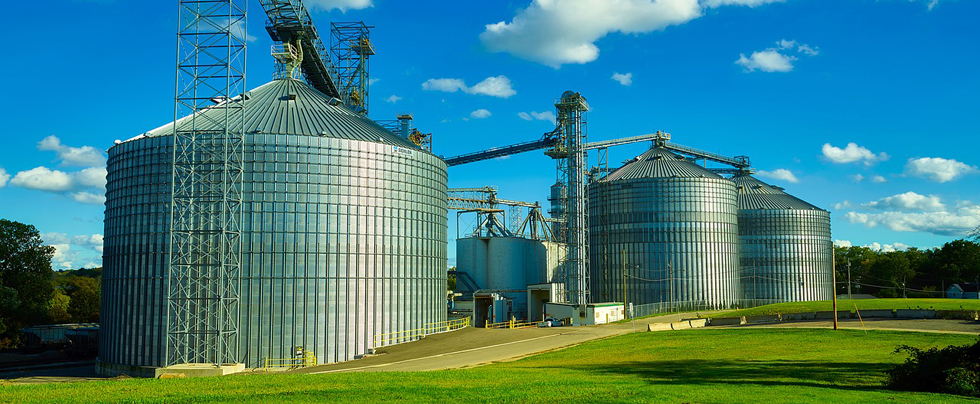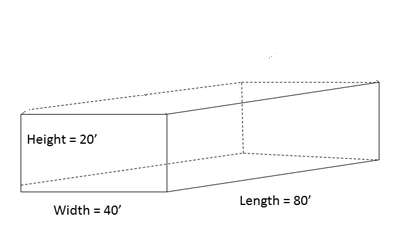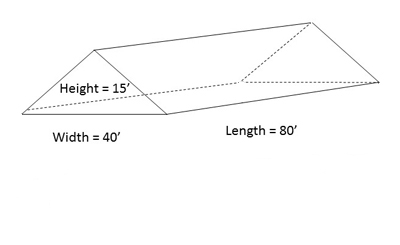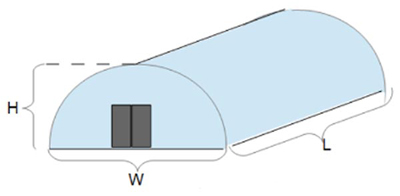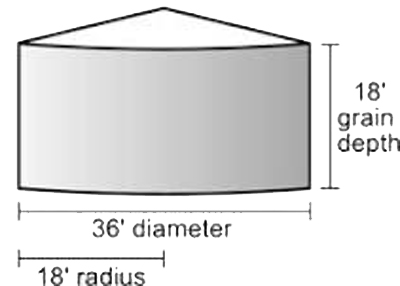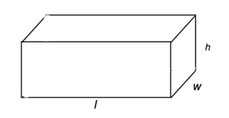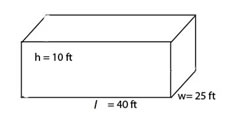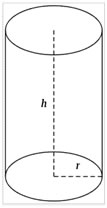Dosage recommendations are based on cubic content.
Volume calculations are the basis for determining the amount of fumigant needed for enclosed spaces. They are straightforward as long as you break them down into individual steps.
The example structure is 80 ft long x 40 ft wide x 20 ft high.
The formula for the volume of this structure is 1,017.4 sq ft x 18 ft = 18,312.5 cu ft
Good Practice Checklist For Fumigation
This checklist emphasizes steps related to life safety and fire safety. However, all items do not apply to all fumigants in all situations. This is intended as an outline for a more detailed operating procedure for fumigations.
Planning & Preparation
 Become fully acquainted with site and commodity to be fumigated, including:
Become fully acquainted with site and commodity to be fumigated, including:
1. General layout of the structure, connecting and adjacent structures, and above- and belowground escape routes.
a. Check equipment to ensure that product flow has ceased and that equipment has been made as tight as practicable to prevent drafts and/or leaks. This applies especially to spot fumigations,
b. Check all spouts, conveyers, conduit heat pipes or other possible openings leading from the area to be fumigated.
2. The number and identification of persons who routinely enter the area to be fumigated and the proximity of other persons and animals.
3. The specific commodity, its condition, and mode of storage.
4. The commodity's treatment history, if available, to be aware of possible food residues.
5. Accessibility of utility service connections.
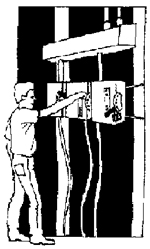
Locate utility service connections
(Photo: Nasdonline.org)
6. Locate the emergency shut-off stations for electricity, water, and gas.
 Post current emergency telephone numbers, i.e., Fire, Police, Hospital, and Physician.
Post current emergency telephone numbers, i.e., Fire, Police, Hospital, and Physician.
 Select an appropriate EPS-registered fumigant.
Select an appropriate EPS-registered fumigant.
1. Make sure the selected chemical or chemicals will not leave illegal residues.
2. Check, mark, and prepare the application points for spot or general fumigation.
3. Determine the dosage rates. Consider the structure's type, size, temperature, and humidity. Determine how well the structure can be sealed, any label restrictions, and the sorption of the fumigant. Fumigators develop good judgment about specific situations with experience.
 Study directions, warnings, antidotes, and precautions on the label and on the manufacturer's instruction manual.
Study directions, warnings, antidotes, and precautions on the label and on the manufacturer's instruction manual.
 Notify local fire and police authorities and other security personnel about the proposed fumigation's location, date and time, the chemicals to be used, type of protective equipment required, and fire hazard rating.
Notify local fire and police authorities and other security personnel about the proposed fumigation's location, date and time, the chemicals to be used, type of protective equipment required, and fire hazard rating.
 Inform local hospital emergency rooms of your fumigation practices and the specific materials used.
Inform local hospital emergency rooms of your fumigation practices and the specific materials used.
 Provide authorities with pertinent safety literature on the materials to be used.
Provide authorities with pertinent safety literature on the materials to be used.
 Arrange for standby equipment, replacement parts, and an alternate plan of action.
Arrange for standby equipment, replacement parts, and an alternate plan of action.
 Inform all employees of the operational schedule, potential hazards to life and property, and the required safety measures and emergency procedures.
Inform all employees of the operational schedule, potential hazards to life and property, and the required safety measures and emergency procedures.
 Prepare warning signs for posting treated areas, provide for security of building, and arrange for watchmen when required.
Prepare warning signs for posting treated areas, provide for security of building, and arrange for watchmen when required.
 Have available first aid equipment and antidotes where applicable.
Have available first aid equipment and antidotes where applicable.
 Plan for application from outside the structure where possible.
Plan for application from outside the structure where possible.
 Plan for ventilating the treated space and commodities when the required exposure is finished. Do this before you start treatment.
Plan for ventilating the treated space and commodities when the required exposure is finished. Do this before you start treatment.
 Properly identify areas used for storage of fumigant chemicals and provide the conditions required by the manufacturer’s directions
Properly identify areas used for storage of fumigant chemicals and provide the conditions required by the manufacturer’s directions
 Make sure there are no open fires, motors, or light switches that could spark, or hot surfaces, such as heat pipes and electric fixtures, within the space to be fumigated.
Make sure there are no open fires, motors, or light switches that could spark, or hot surfaces, such as heat pipes and electric fixtures, within the space to be fumigated.
 Provide fans to distribute the fumigant where applicable.
Provide fans to distribute the fumigant where applicable.
 Provide gas sampling and/or detection device.
Provide gas sampling and/or detection device.
 Make a final check to clear all personnel and non-target animals from the space to be fumigated
Make a final check to clear all personnel and non-target animals from the space to be fumigated
